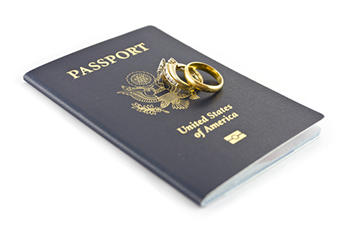Married to United States Citizen vs. Green Card Holder

What’s the difference between being married to a United States citizen compared to married to a lawful permanent resident (a green card holder)?
Spouses of lawful permanent residents and spouses United States citizens can often obtain lawful permanent residence (the green card) in the United States. The forms are the same and the process is often very similar, especially when the spouse lives outside the United States. There are critical differences, though.
This blog reviews the major similarities and differences. Every case is unique and United States immigration laws have changed over time. There are exceptions in every situation and it is important to speak with a competent immigration attorney about your specific situation.
The similarities
The basic process for each case is the same because the foundation of each case is the same. The United States citizen or the lawful permanent resident files a petition with USCIS (United States Citizenship and Immigration Services) for his or her spouse. In effect, this petition says, “I am a United States citizen or lawful permanent resident. My spouse is not. Please let him or her apply for lawful permanent residence.” The approval of this petition does not give lawful status to the foreign national spouse.
Regardless of whether the petitioner is a United States citizen or a lawful permanent resident, if the foreign national spouse lives outside the United States, the spouse will apply for an immigrant visa at the United States consulate in his or her home country after the petition is approved. After the immigrant visa is issued, the foreign national spouse comes to the United States and is admitted as a lawful permanent resident.
Also, both a spouse of a United States citizen and a spouse of a lawful permanent resident must prove that he or she is not inadmissible to the United States. Briefly, the immigrating spouse must prove that he or she is not a public charge, does not have a bad immigration history or a criminal history, and is not a threat to public health or national security. If the immigrating spouse is inadmissible to the United States, he or she will not be given a green card unless he or she receives an approved waiver of that ground of inadmissibility. Not all grounds of inadmissibility are waivable.
This means that if the foreign national entered the United States without inspection (crossed the border unlawfully), the foreign national cannot apply for lawful permanent residence in the United States regardless of whether he or she is married to a United States citizen or a lawful permanent resident.
The differences
There are two substantial differences between being married to a United States citizen and being married to a lawful permanent resident.
The first biggest difference is when the foreign national spouse actually receives the lawful permanent residence. Spouses of United States citizens, like all immediate relatives of United States citizens, are exempt from the immigrant visa preference quotas. Simply put, a spouse of a United States citizen will be able to apply for lawful permanent residence and will be able to receive lawful permanent residence as fast as the government can act. “Fast” may be a relative term, because it can still take a long time to immigrate to the United States. However, there are no legal limits on how many spouses of United States citizens can receive lawful permanent residence in any one year.
There is a quota on the number of spouses of lawful permanent residents who can become lawful permanent residents each year. As a practical matter, right now, that means that a spouse of a lawful permanent resident has to wait an additional eighteen months after the approval of the lawful permanent resident’s petition before the spouse can apply for a green card.
The second biggest difference is whether the foreign national spouse can apply for lawful permanent residence while in the United States. A spouse of a United States citizen who was admitted to the United States on most types of visas (although not all visas), can apply for lawful permanent residence in the United States even if he or she is currently not in lawful status. In other words, a spouse of a United States citizen who entered the United States on a good visa usually can apply for the green card in the United States even if that visa has expired or if he or she has worked without authorization.
A spouse of a lawful permanent resident must be in lawful status in order to apply for lawful permanent residence in the United States. Since spouses of lawful permanent residents have to wait an additional eighteen months before they can apply for their green cards, this often means that a spouse of a lawful permanent resident cannot apply for a green card in the United States unless the spouse has a long-term, nonimmigrant visa like some work visas. If the foreign national spouse’s status has expired, then he or she leave the United States and apply for the immigrant visa at the United States consulate overseas.
The nuances
There are three subtle differences between a spouse of a United States citizen and a spouse of a lawful permanent resident which do not always impact every case.
A spouse of a United States citizen who entered the United States unlawfully can apply for a waiver of the three year or the ten year bar while in the United States, before traveling to consulate to apply for an immigrant visa. A spouse of a lawful permanent resident who is subject to the three or ten year bars must apply for the waiver while outside the United States. As a practical matter, this means that lawful permanent residents are separated from their spouses for a longer time period and have more risk that the separation will be even longer.
A spouse of a United States citizen may apply for United States citizenship (naturalization) after being a lawful permanent resident for three years. A spouse of a lawful permanent resident must wait five years before being eligible to apply for United States citizenship.
However, spouses of lawful permanent residents receive green cards that are valid for ten years, while many spouses of United States citizens have initial cards that are only valid for two years. This is because people who receive their green cards within two years of marriage are audited after two years of lawful permanent residence. Spouses of lawful permanent residents, because of the eighteen month backlog created by the quotas, never receive their green cards within two years of marriage.
Conclusion
Being married to a lawful permanent resident is like being married to a United States citizen; both give an immigration benefit and a path to becoming a lawful permanent resident and later, a United States citizen. However, neither path is automatic. In both situations, there are a number of filings with USCIS or the Department of State and the foreign national spouse has to prove that he or she is admissible to the United States. Additionally, the path for a spouse of a lawful permanent resident is longer and has more hurdles.

